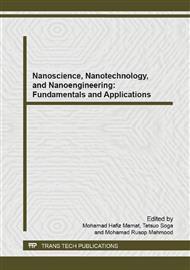[1]
Z. Chen and C. Lu, Humidity Sensors: A Review of Materials and Mechanisms, Sens. Lett., vol. 3, no. 4, p.274–295, Dec. (2005).
Google Scholar
[2]
J. Xie, H. Wang, Y. Lin, Y. Zhou, and Y. Wu, Highly sensitive humidity sensor based on quartz crystal microbalance coated with ZnO colloid spheres, Sensors Actuators B Chem., vol. 177, p.1083–1088, Feb. (2013).
DOI: 10.1016/j.snb.2012.12.033
Google Scholar
[3]
E. Pál, V. Hornok, R. Kun, A. Oszkó, T. Seemann, I. Dékány, and M. Busse, Hydrothermal synthesis and humidity sensing property of ZnO nanostructures and ZnO-In(OH)3 nanocomposites., J. Colloid Interface Sci., vol. 378, no. 1, p.100–9, Jul. (2012).
DOI: 10.1016/j.jcis.2012.04.050
Google Scholar
[4]
X. Zhou, J. Zhang, T. Jiang, X. Wang, and Z. Zhu, Humidity detection by nanostructured ZnO: A wireless quartz crystal microbalance investigation, Sensors Actuators A Phys., vol. 135, no. 1, p.209–214, Mar. (2007).
DOI: 10.1016/j.sna.2006.07.001
Google Scholar
[5]
Q. Qi, T. Zhang, Q. Yu, R. Wang, Y. Zeng, L. Liu, and H. Yang, Properties of humidity sensing ZnO nanorods-base sensor fabricated by screen-printing, Sensors Actuators B Chem., vol. 133, no. 2, p.638–643, Aug. (2008).
DOI: 10.1016/j.snb.2008.03.035
Google Scholar
[6]
S. Jagtap and K. R. Priolkar, Evaluation of ZnO nanoparticles and study of ZnO–TiO2 composites for lead free humidity sensors, Sensors Actuators B Chem., vol. 183, p.411–418, Jul. (2013).
DOI: 10.1016/j.snb.2013.04.010
Google Scholar
[7]
J. -L. Hou, C. -H. Wu, and T. -J. Hsueh, Self-biased ZnO nanowire humidity sensor vertically integrated on triple junction solar cell, Sensors Actuators B Chem., vol. 197, p.137–141, Jul. (2014).
DOI: 10.1016/j.snb.2014.02.073
Google Scholar
[8]
N. Sakly, A. Haj Said, and H. Ben Ouada, Humidity-sensing properties of ZnO QDs coated QCM: Optimization, modeling and kinetic investigations, Mater. Sci. Semicond. Process., vol. 27, p.130–139, Nov. (2014).
DOI: 10.1016/j.mssp.2014.06.027
Google Scholar
[9]
T. Ates, C. Tatar, and F. Yakuphanoglu, Preparation of semiconductor ZnO powders by sol–gel method: Humidity sensors, Sensors Actuators A Phys., vol. 190, p.153–160, Feb. (2013).
DOI: 10.1016/j.sna.2012.11.031
Google Scholar
[10]
N. D. M. Sin, S. Ahmad, M. F. Malek, M. H. Mamat, and M. Rusop, Improvement sensitivity humidity sensor based on ZnO/SnO 2 cubic structure, IOP Conf. Ser. Mater. Sci. Eng., vol. 46, p.012005, Jun. (2013).
DOI: 10.1088/1757-899x/46/1/012005
Google Scholar
[11]
M. H. Mamat, Z. Khusaimi, M. Z. Musa, U. M. Noor, M. Rusop, and S. Alam, Electrical and Structural Properties of Aligned Aluminum-Doped Zinc Oxide Nanorod Arrays via a Novel Sonicated Sol-Gel Immersion, p.1–5.
DOI: 10.1109/eit.2011.5978587
Google Scholar
[12]
M. H. Mamat, M. Z. Musa, and M. Rusop, Effect of Growth Duration to the Electrical Properties Application, p.86–91, (2012).
Google Scholar
[13]
M. H. Mamat, N. N. Hafizah, and M. Rusop, Fabrication of thin, dense and small-diameter zinc oxide nanorod array-based ultraviolet photoconductive sensors with high sensitivity by catalyst-free radio frequency magnetron sputtering, Mater. Lett., vol. 93, p.215–218, Feb. (2013).
DOI: 10.1016/j.matlet.2012.11.105
Google Scholar
[14]
H. J. Jo and E. S. Kim, Effect of Sn4+ substitution on microwave dielectric properties of (Mg0. 95Ni0. 05)(Ti1−xSnx)O3 ceramics, Mater. Res. Bull., p.3–7, Jul. (2014).
DOI: 10.1016/j.materresbull.2014.07.041
Google Scholar


